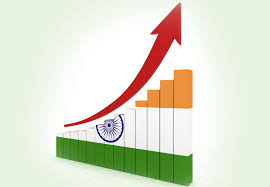
The Indian economy grew at a rate of 8.2 per cent during the first quarter of the financial year 2018-19 making it the fastest growing major economy in the world for the same time period. The economy’s strong show in the April-June quarter was driven by strong core performance and a healthy base.
"GDP at constant (2011-12) prices in Q1 of 2018-19 is estimated at Rs 33.74 lakh crore, as compared to Rs 31.18 lakh crore in Q1 of 2017-18, showing a growth rate of 8.2 percent. Quarterly GVA at basic price at constant (2011-2012) prices for Q1 of 2018-19 is estimated Rs 31.63 lakh crore, as against Rs 29.29 lakh crore in Q1 of 2017-18, showing a growth rate of 8.0 percent over the corresponding quarter of previous year," said a statement by the Ministry of Statistics and Programme Implementation.
The growth rate is also apparently an encouragement for the country’s Prime Minister Narendra Modi's decision on demonetisation and the implementation of GST both of which had initially led to a slowdown in the economy. in comparison, China reported a 6.7 per cent growth for June quarter on the back of a 6.8 per cent growth in the March quarter.
The June quarter FDP growth rate for the Indian economy is also the fastest achieved by it in the last eight quarters. The previous best was achieved in the July-September quarter in 2016 at 9.2 per cent. In the April-June quarter in 2017, the Indian economy had slowed down to 5.6 per cent but picked up speed and touched 7.7 per cent in the July-September quarter in 2017.
There are a number of global factors hat have not been favorable for the Indian economy such as the rising oil prices which had severely hit the Indian currency – the rupee. There had also been an extension of the current account deficit. Under such circumstances, this GDP growth figure can be considered to be a relief for the Indian government. This figure is also likely to be critical for setting up of the monetary policy before the meeting of the next Reserve Bank of India – the country’s central banker on October 3-5.
According to data by Ministry of Statistics and Programme Implementation, manufacturing, electricity, gas, water supply and other utility services, construction, and public administration, defence and other services were the industry sectors that clocked over 7 per cent in growth.
The best performer among the sectors was manufacturing which clocked a quarterly growth of GVA at basic prices at 13.5 per cent as compared to a negative growth of 1.8 per cent in same period last fiscal year. Construction was the second best performer with a quarterly growth rate of 8.7 per cent.
(Source:www.businesstoday.in)
"GDP at constant (2011-12) prices in Q1 of 2018-19 is estimated at Rs 33.74 lakh crore, as compared to Rs 31.18 lakh crore in Q1 of 2017-18, showing a growth rate of 8.2 percent. Quarterly GVA at basic price at constant (2011-2012) prices for Q1 of 2018-19 is estimated Rs 31.63 lakh crore, as against Rs 29.29 lakh crore in Q1 of 2017-18, showing a growth rate of 8.0 percent over the corresponding quarter of previous year," said a statement by the Ministry of Statistics and Programme Implementation.
The growth rate is also apparently an encouragement for the country’s Prime Minister Narendra Modi's decision on demonetisation and the implementation of GST both of which had initially led to a slowdown in the economy. in comparison, China reported a 6.7 per cent growth for June quarter on the back of a 6.8 per cent growth in the March quarter.
The June quarter FDP growth rate for the Indian economy is also the fastest achieved by it in the last eight quarters. The previous best was achieved in the July-September quarter in 2016 at 9.2 per cent. In the April-June quarter in 2017, the Indian economy had slowed down to 5.6 per cent but picked up speed and touched 7.7 per cent in the July-September quarter in 2017.
There are a number of global factors hat have not been favorable for the Indian economy such as the rising oil prices which had severely hit the Indian currency – the rupee. There had also been an extension of the current account deficit. Under such circumstances, this GDP growth figure can be considered to be a relief for the Indian government. This figure is also likely to be critical for setting up of the monetary policy before the meeting of the next Reserve Bank of India – the country’s central banker on October 3-5.
According to data by Ministry of Statistics and Programme Implementation, manufacturing, electricity, gas, water supply and other utility services, construction, and public administration, defence and other services were the industry sectors that clocked over 7 per cent in growth.
The best performer among the sectors was manufacturing which clocked a quarterly growth of GVA at basic prices at 13.5 per cent as compared to a negative growth of 1.8 per cent in same period last fiscal year. Construction was the second best performer with a quarterly growth rate of 8.7 per cent.
(Source:www.businesstoday.in)














